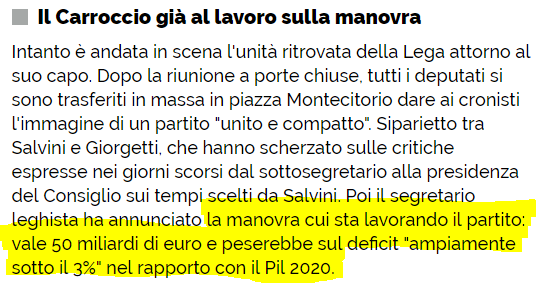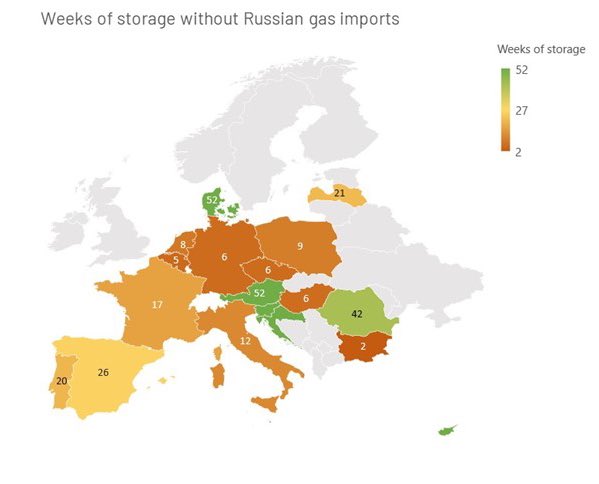Salvini dice che la manovra sarà da 50 mld e sarebbe ampiamente sotto il 3% del PIL. Ma non è tutto oro quel che luccica (segue aritmetica)
agi.it/politica/crisi…
agi.it/politica/crisi…

Facciamo 2 conti:
Deficit tendenziale 2020 = 1.5-1.7%
- Reddito di Cittadinanza: 0.4% (draft budget 11/2018)
= 1.1%-1.3%
- 80 euro Renzi: 9.5 mld = 0.5%
= 0.6%-0.8%
ci avanzano: 3% - (0.7%-0.9%) = 2.3-2.1% = 41-38mld
- sterilizzazione IVA: 23mld (1.3%)
= 15-18 mld liberi
Deficit tendenziale 2020 = 1.5-1.7%
- Reddito di Cittadinanza: 0.4% (draft budget 11/2018)
= 1.1%-1.3%
- 80 euro Renzi: 9.5 mld = 0.5%
= 0.6%-0.8%
ci avanzano: 3% - (0.7%-0.9%) = 2.3-2.1% = 41-38mld
- sterilizzazione IVA: 23mld (1.3%)
= 15-18 mld liberi
Questo assumendo che vengano tagliati RdC e 80 euro. Se venisse tagliato solo RdC:
Deficit 2020 = 1.5-1.7%
- Reddito di Cittadinanza: 0.4% (draft budget 11/2018)
= 1.1%-1.3%
ci avanzano: 3% - (1.2%-1.4%) = 1.8-1.6% = 32-29mld
- sterilizzazione IVA: 23mld
= 9-6 mld liberi
Deficit 2020 = 1.5-1.7%
- Reddito di Cittadinanza: 0.4% (draft budget 11/2018)
= 1.1%-1.3%
ci avanzano: 3% - (1.2%-1.4%) = 1.8-1.6% = 32-29mld
- sterilizzazione IVA: 23mld
= 9-6 mld liberi
Quindi, se prendiamo Salvini in parola:
1) I 50mld diventano 15-18 una volta sterilizzata IVA. Flat tax per tutti molto lontana,
2) questo se tagliamo RdC e 80€, quindi grosso impatto redistributivo da poveri a ricchi
3) se tagliamo solo RdC, i mld liberi sono solo 7-9
1) I 50mld diventano 15-18 una volta sterilizzata IVA. Flat tax per tutti molto lontana,
2) questo se tagliamo RdC e 80€, quindi grosso impatto redistributivo da poveri a ricchi
3) se tagliamo solo RdC, i mld liberi sono solo 7-9
Se invece non prendiamo Salvini in parola ma assumiamo che i 50 mld siano tutti per la flat tax (che, ricordiamo, costa 50-70mld) allora anche togliendo RdC e 80 euro:
= 0.6%-0.8%
+ 50mld (2.8%)
= 3.6%
+ sterilizzazione IVA (1.3%)
= 4.9%
=> tanti auguri
= 0.6%-0.8%
+ 50mld (2.8%)
= 3.6%
+ sterilizzazione IVA (1.3%)
= 4.9%
=> tanti auguri
• • •
Missing some Tweet in this thread? You can try to
force a refresh

















